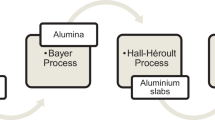Abstract
The burden distribution in the blast furnace has a major impact on the process and its stability. The iron bearing burden consists usually of several components, such as sinter, pellets, lump ore, silica addition, and nut coke. Therefore, the exact composition at discrete positions and times in the blast furnace is of great interest. While the charging via a rotating chute is well investigated by computationally costly methods like Discrete Element Method, there is a lack of models with real time capabilities to track the burden materials. This holds especially if not only a single process is in the focus but the tracking incorporates blending operations on conveyer belts, in hoppers and finally on the chute and in the blast furnace. In the current work, a concept to model the material flow along the process chain from stock house to blast furnace is presented. The focus of this paper is to simulate material discharged from the hopper and the distribution of the material inside the blast furnace. The hopper is modelled by a cellular automaton, the material position after charging is calculated by a semi-empirical charging model. The material in the models can always be associated with additional information like the chemical analysis or the screen size. Both models are coupled and displayed via a web interface. The model enables the offline optimization of the burden distribution from the hopper up to the blast furnace and also for online guidance and recommendations for the blast furnace operators.
Zusammenfassung
Die Möllerverteilung im Hochofen hat einen großen Einfluss auf den Prozess und seine Stabilität. Der Möller besteht in der Regel aus mehreren Komponenten, wie Sinter, Pellets, Stückerz, Kies und Kleinkoks. Daher ist die genaue Zusammensetzung an einzelnen Positionen und zu bestimmten Zeiten im Hochofen von großem Interesse. Während die Beschickung über eine Drehschurre mit rechenaufwändigen Methoden wie der Diskreten-Elemente-Methode gut untersucht ist, fehlt es an echtzeitfähigen Modellen zur Verfolgung des Möllers. Dies gilt insbesondere dann, wenn nicht nur ein einzelner Prozess im Fokus steht, sondern die Verfolgung auch Mischvorgänge auf Förderbändern, in Bunkern und schließlich auf der Schurre und im Hochofen umfasst. In der vorliegenden Arbeit wird ein Konzept zur Modellierung des Materialflusses entlang der Prozesskette von der Möllerung zum Hochofen vorgestellt. Der Schwerpunkt dieser Arbeit liegt auf der Simulation des Materialaustrags aus dem Gichtbunker und der Verteilung des Materials im Hochofen. Der Bunker wird durch einen zellulären Automaten modelliert, die Materialposition nach der Ausförderung wird durch ein semi-empirisches Schüttmodell berechnet. Das Material kann in den Modellen immer mit zusätzlichen Informationen wie der chemischen Analyse oder der Siebgröße verknüpft werden. Beide Modelle werden gekoppelt und über ein Webinterface dargestellt. Das Modell ermöglicht sowohl die Offline-Optimierung der Möllerverteilung vom Bunker in der Möllerung bis zum Hochofen als auch die Online-Visualisierung und Steuerungsempfehlungen für die Betreiber des Hochofens.






Similar content being viewed by others
References
Kreutz, L., Bergmann, B.: Materialverteilung im Hochofen bei Verwendung einer Drehschurre als Begichtungssystem. Stahl Eisen 108, 874–880 (1988)
Firewicz, H.: Kinetik des Schwerkraft-Auslaufs körnigen Gutes aus einem Bunker. Aufbereitung Tech 25, 209–214 (1984)
Miyagawa, S., Takeda, K., Taguchi, S., Itaya, H., Fujimori, H., Morimoto, T., Sawada, T.: Development of a bell-less top with three-parallel-bunkers and its operation results at Mitzushima no.3 blast furnace. ISIJ (1992). https://doi.org/10.2320/materia1962.31.330
Windows-Yule, C.R.K., Tunuguntla, D.R., Parker, D.J.: Numerical modelling of granular flows: a reality check. Comput. Part. Mech. 3, 311–332 (2016)
Mio, H., Narita, Y., Nakano, K., Nomura, S.: Validation of the burden distribution of the 1/3-scale of a blast furnace simulated by the discrete element method. Processes (2020). https://doi.org/10.3390/pr8010006
Degrassi, G., Parussini, L., Boscolo, M., Petronelli, N., Dimastromatteo, V.: Discrete element simulation of the charge in the hopper of a blast furnace, calibrating the parameters through an optimization algorithm. Sn Appl. Sci. 3, 242 (2021). https://doi.org/10.1007/s42452-021-04254-8
Mitra, T., Saxén, H.: Discrete element simulation of charging and mixed layer formation in the ironmaking blast furnace. Comput. Part. Mech. 3, 541–555 (2016)
Marinack, M.C., Higgs, C.F.: Three-dimensional physics-based cellular automata model for granular shear flow. Powder Technol. 277, 287–302 (2015)
LaMarche, K.R., Conway, S.L., Glasser, B.J., Shinbrot, T.: Cellular automata model of gravity-driven granular flows. Granul. Matter 9, 219–229 (2007)
Marks, B., Einav, I.: A cellular automaton for segregation during granular avalanches. Granul. Matter 13, 211–214 (2011)
Baxter, W.B., Behringer, R.P.: Cellular automata models for the flow of granular materials. Physica D. 51, 465–471 (1991)
Otto, H., Rößler, T., Katterfeld, A.: Rückverfolgbarkeit von Schüttgütern in der Lebensmittelverarbeitung. Logist. J. Proc. (2019). https://doi.org/10.2195/lj_Proc_otto_de_201912_01
OPC: UA Whitepaper. https://opcfoundation.org/wp-content/uploads/2020/09/OPC-11030-Whitepaper-UA-Modeling-Best-Practices-1.00.00.pdf, Accessed 30 Apr 2021
Eclipse Milo™—an open source implementation of OPC UA (IEC 62541). https://github.com/eclipse/milo, Accessed 30 Apr 2021
Fielding, R.T.: Architectural styles and the design of network-based software architectures. Doctoral Dissertation. Irvine (2000)
Grafana labs. https://grafana.com/, Accessed 30 Apr 2021
Geerdes, M., Chaigneau, R., Lingiardi, O., Molenar, R., van Opbergen, R., Sha, Y., Warren, P.: Modern blast furnace ironmaking: an introduction, 4th edn. IOS Press, Amsterdam (2020)
Kaldenhoff, M.: Simulation von grobgranularen Schüttgütern mit Hilfe Zellulärer Automaten. Dissertation. Braunschweig (1998)
Kozicki, J., Tejchman, J.: Simulations of flow patterns in silos with a Callular automaton: part 1. Task Q. 9, 81–102 (2005)
Kozicki, J., Tejchman, J.: Simulations of flow patterns in silos with a cellular automaton: part 2. Task Q. 9, 103–114 (2005)
Plotly. https://plotly.com/, Accessed 30 Apr 2021
Sibagatullin, K.S., Kharchenko, A.S., Savchenko, Yu, G., Beginyuk, V.A.: Blast furnace performance improved through optimum radial distribution of materials at the top while changing charging pattern. CIS Iron Steel Rev. 16, 11–14 (2018)
Author information
Authors and Affiliations
Corresponding author
Additional information
Publisher’s Note
Springer Nature remains neutral with regard to jurisdictional claims in published maps and institutional affiliations.
Rights and permissions
About this article
Cite this article
Hojda, S., Pollet, M., Busch, H. et al. Real Time Modelling of Burden Components Distribution During Hopper Outflow and Burdening Via a Rotating Chute. Berg Huettenmaenn Monatsh 167, 107–113 (2022). https://doi.org/10.1007/s00501-022-01208-4
Received:
Accepted:
Published:
Issue Date:
DOI: https://doi.org/10.1007/s00501-022-01208-4




